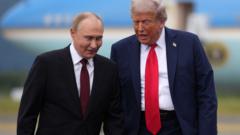The recent meeting between US President Donald Trump and Russian President Vladimir Putin in Alaska has concluded without a breakthrough regarding the protracted conflict in Ukraine. Trump's assertion that “there's no deal until there's a deal” encapsulates the lack of tangible outcomes from the encounter. While the summit was expected to possibly establish a ceasefire, it ended in less than three hours with only a joint statement released to the press.
As the leaders met at Joint Base Elmendorf-Richardson, the events were meticulously staged, featuring Putin's arrival on a red carpet and photo opportunities alongside Trump. However, despite the elaborate setup and both leaders’ charismatic displays during the meeting, progress on the critical issues surrounding Ukraine remained elusive. Putin reiterated his long-standing demands, insisting that Ukraine must withdraw from regions partially occupied by Russia and abandon its NATO aspirations.
Ukrainian President Volodymyr Zelensky, who was not present at the talks, is firmly against conceding any territory, fearing that such actions might encourage further Russian aggression. The backdrop of their meeting echoes the ongoing conflict which began with Russia's annexation of Crimea in 2014, and escalated into a full-scale invasion more than three years ago.
After the meeting, President Trump expressed confidence about “great progress” but did not specify any significant breakthroughs. He mentioned that while "many points were agreed to," a few crucial issues remain contentious between the two powers, leaving the door open for future discussions.
Post-summit reactions include a call between Trump and Zelensky, who will be traveling to Washington to discuss a trilateral meeting involving NATO leaders. Zelensky emphasized a need for security guarantees for Ukraine, highlighting the urgency of international support to deter further Russian threats.
While both leaders exhibited cordiality during their meeting, the public rhetoric used by Putin emphasized justifications for his initial invasion objectives, fueling concerns about Ukraine’s future independence. With no peace agreement achieved, observers are left contemplating the implications of the summit for the ongoing war and future diplomatic relations.
As the leaders met at Joint Base Elmendorf-Richardson, the events were meticulously staged, featuring Putin's arrival on a red carpet and photo opportunities alongside Trump. However, despite the elaborate setup and both leaders’ charismatic displays during the meeting, progress on the critical issues surrounding Ukraine remained elusive. Putin reiterated his long-standing demands, insisting that Ukraine must withdraw from regions partially occupied by Russia and abandon its NATO aspirations.
Ukrainian President Volodymyr Zelensky, who was not present at the talks, is firmly against conceding any territory, fearing that such actions might encourage further Russian aggression. The backdrop of their meeting echoes the ongoing conflict which began with Russia's annexation of Crimea in 2014, and escalated into a full-scale invasion more than three years ago.
After the meeting, President Trump expressed confidence about “great progress” but did not specify any significant breakthroughs. He mentioned that while "many points were agreed to," a few crucial issues remain contentious between the two powers, leaving the door open for future discussions.
Post-summit reactions include a call between Trump and Zelensky, who will be traveling to Washington to discuss a trilateral meeting involving NATO leaders. Zelensky emphasized a need for security guarantees for Ukraine, highlighting the urgency of international support to deter further Russian threats.
While both leaders exhibited cordiality during their meeting, the public rhetoric used by Putin emphasized justifications for his initial invasion objectives, fueling concerns about Ukraine’s future independence. With no peace agreement achieved, observers are left contemplating the implications of the summit for the ongoing war and future diplomatic relations.






















